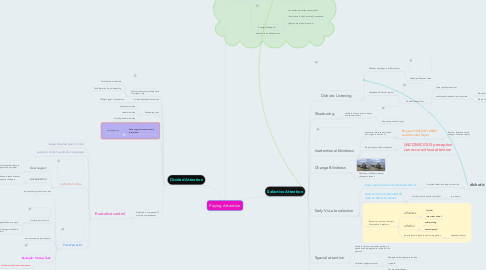
1. Divided Attention
1.1. skill of performing multiple task simultaneously
1.1.1. Task that don't interfere
1.1.2. Task that aren't too demanding
1.2. Limited attentional resources
1.2.1. Different types of resources
1.3. Shadowing task
1.3.1. auditory modality
1.3.2. visual modality
1.3.3. Visual/pictorial modality
1.4. Some cognitive resources are specialized
1.4.1. some general
1.5. Attention is composed of multiple componenets
1.5.1. Executive control
1.5.1.1. keeps desired goal in mind
1.5.1.2. serves to inhibit automatic responses
1.5.1.3. prefrontal cortex
1.5.1.3.1. Goal neglect
1.5.1.3.2. preservation
1.5.1.4. Practiced skills
1.5.1.4.1. require less cognitive resources
1.5.1.4.2. Improve performance
1.5.1.4.3. reduces capacity requirements
1.5.1.4.4. Example: Stroop Task
1.5.1.4.5. Automaticity
2. Attention
2.1. William James (1890)
2.1.1. "Implies withdrawal from some things in order to deal effectively with others..."
2.2. “Everyone knows what attention is. It is the taking possession by the mind, in clear and vivid form, of one out of what seem several simultaneously possible objects or trains of thought. Focalization, concentration, of consciousness are of its essence.”
2.3. Spotlight Metaphor
2.3.1. Illuminates part ofthe sensory field
2.3.2. information in light is actively processed
2.3.3. light can be broad or narrow
2.4. attention Is an Achievement
3. Selective Attention
3.1. Dichotic Listening
3.1.1. Different messages in different ears
3.1.1.1. Attended Channel- listen
3.1.2. Unattended Channel- ignore
3.1.2.1. Cocktail Party effect
3.1.2.1.1. Other parties tuned out
3.1.2.1.2. unattended channels can be noticed
3.2. Shadowing
3.2.1. ability to focus on some inputs and ignore others
3.2.1.1. Repeating an audio track
3.3. Inattentional blindness
3.3.1. can cause failure to see stimuli that's right in front of us
3.3.1.1. Employs FIXATION TARGET and Attended Target
3.3.1.1.1. Results: failure to notice change in fixation target
3.3.2. No perception without attention
3.3.2.1. UNCONSCIOUS perception can occur without attention
3.4. Change Blindness
3.4.1. Definition: inability to detect changes in scenes
3.5. Early Vs Late selection
3.5.1. Early: we can block out irrelevant stimuli
3.5.1.1. Complex stimuli involving more effort
3.5.1.1.1. dichotic
3.5.2. Late: stimuli not attended do have an effect on stimuli
3.5.2.1. familiar stimuli involve less effort
3.5.2.1.1. your name
3.5.3. Resources: priming that gets allocated to detectors
3.5.3.1. effortless
3.5.3.1.1. familiar
3.5.3.1.2. important stimuli
3.5.3.2. effortful
3.5.3.2.1. uninteresting
3.5.3.2.2. unanticipated
3.5.3.3. lower threshold leads to easier recognition
3.5.3.3.1. attended channel
3.6. Spacial attantion
3.6.1. ability to focus on particular position in space and be prepared for stimuli in the position
3.6.2. Unilateral neglect syndrom
3.6.2.1. Damage to the right parietal lobe
3.6.2.2. urged to
3.6.2.3. Can be object based
3.7. Priming
3.7.1. Posner and Snyder (1975)
3.7.1.1. Stimulus based priming
3.7.1.1.1. effortless
3.7.1.2. expectation based
3.7.1.2.1. effortful
3.7.2. Stimulus Based Priming
3.7.2.1. fast
3.7.2.2. few cost
3.7.3. expectation based priming
3.7.3.1. slow
3.7.3.2. more costly
3.7.4. may be implied to places
